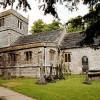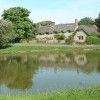The Lerret is a traditional Dorset boat designed specifically for use off the Chesil Beach. They have been around for at least four centuries; David Carter found one mention of a Lerret in the minutes of Weymouth Council of 1615: “…Mr Mayor J. Roy also furthered Harbour Works eg 2 Lerretts to save the towne boatt from castinge awaye £0.7s.4d…”
Alas, in the name of ‘progress’ and in common with many of the old ways, they are disappearing. In 2010 a new boat was built and launched at Lyme Regis but other than that David Carter, who has made a study of the boats, tells us he believes only four still exist: Pleasure, Blessing, Blessing Two and Silver Star. (David has sent us a photo of Silver Star which we have placed in the photo section).
Lerrets were used for fishing off the Cheseil Beach and are known to have been owned by fishermen from Portland, Wyke, Chickerell, Fleet, Langton Herring and Abbotsbury. Information from Weymouth Council suggests that in the early years of the 20th century over 50 Lerrets were in regular use by fishermen from the area. We have some of the names and the owners: Agnes (Before 1914); Bunger (Fred Sergent); Cauliflower (Sid Huddy); Dawn; Fearless; Girl Pat; Lark; Linnet; May Queen; Ping Pong (F & E Sergent); Queen Mary; Rescue (Jim Burlage); Scarisbrick (Henry Pitman); Speedwell and Twilight (George Morris); Bluebell and Comrades (both owned by the landlord of the Swan Inn, at Wyke, Tom Hatcher); Dauntless (George Randall); Ena (known to have been built in 1926); Lucky Liza (Robert Denman); Mackerell; Nellie and Silver Star (Fred and Toby Randall); Plum (John Randall); Vera( a 19th century boat).
At first glance a Lerret appears to be like any other large wooden rowing boat. But look again. Where is the stern and why is the bottom flatter than a conventional boat? Approximately sixteen feet in length with a beam of between five and six feet, there are three main thwarts across the boat, which would usually be rowed by four men seated on the middle and forward seats, although in some circumstances six oars would be used. Lerrets are double-ended with a high stern post to enable them to be launched off the steep Chesil beach and hauled up onto the beach. Their wide beam and unusually flat bottom makes them very buoyant and they will survive all but the most extreme seas.
The oarsmen will pull double-handed, but the rowers on one side pull stroke alternately with those on the other side. Each oar has a block of wood fixed to the loom by spikes and lashing, this block is known as the copse and it has a hole through it to receive the iron thowle pin, and it is fixed to the gunwale of the boat so standing about five inches above it.
The mackerel move to deeper water by the end of August and soon the weather and seas change from their benign summer ways and will become very ill tempered; this is the signal for the Lerrets to be ‘beached in’ for the winter. The boats will be pulled to the top of the beach where it is flat, a hollow is made in the beach and the Lerret ‘sunk’ into it, secured with ropes and boxes of pebbles.
William Bilke will be remembered as one of the Wyke fishermen who one day netted 63,000 mackerel off the Chesil Beach. Despite his success on that trip, like most other fishermen in the area he would have had to find other employment as well as fishing to make a living – in William’s case labouring.
He was born in Wyke Regis in 1876; his father, also William, being a fisherman. His grandfather, another William, was a shoemaker but his grandmother, Mary, was the daughter of Joseph Summers, a fisherman. When her husband died in 1865 Mary Bilke went into business as a general carter and by 1871 her eldest son William (24) and Edward (15), his brother, were established fishermen. At that time boys as young as eight could be found helping the men on the beach.
In 1875 William Bilke married Eliza Hallett, they named their first child, who arrived in 1876, William John, and like his father and uncle he was fishing by the time he was 15. In 1898 William married Janetta Critchell and by 1911 the couple had three sons and two daughters. William John Bilke had a long life; he passed away in 1963 aged 87 years; he was buried at All Saints, Wyke Regis. William was also known for shrimping or prawning in the Fleet Lagoon. He would spend hours at a time raking along with a shrimp net in water up to his waist as he worked with the ebbing tide, but he will forever be remembered for his part in landing the big catch.
Eli Hatcher was born at Osmington in 1827 and came to Wyke Regis in the 1840’s to find a bride and employment. He married Elizabeth Roberts late in 1849 and became the landlord of the Swan Inn, where he and his sons would have come into contact with the fishermen of Wyke. Indeed his son Thomas who took over as landlord at the Swan in the 1890’s described himself as an innkeeper and fisherman and is known to have owned two Lerrets.
The Lerret has earned its place in Dorset’s maritime history. Primarily a fishing boat, their crews have often risked their own lives launching into challenging seas to rescue mariners in difficulty on the turbulent seas off our coast.
There are photos of Lerrets in the photo gallery.



